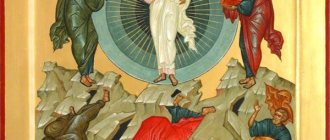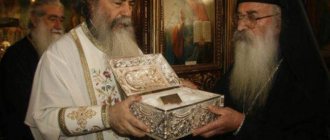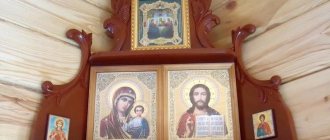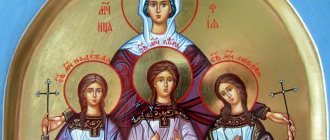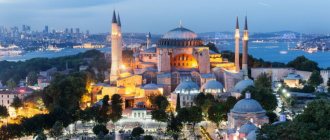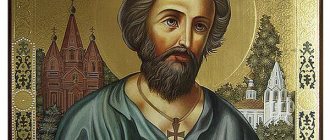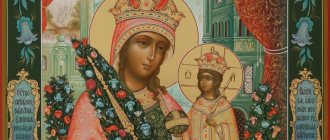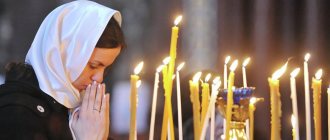This image is one of the most interesting in Orthodox icon painting, although, of course, there are other curious and unusual icons. Here we can see an interesting concept of representing the Mother of God in an allegorical form. Before the believers is the icon of Sophia the Wisdom of God, on which the Most Pure Virgin appears in the form of wisdom, that is, we are talking not so much about a specific person, but about the quality that was embodied through this person.
The meaning of the icon “Sophia the Wisdom of God”
In fact, the meaning of this icon is multifaceted and deep; in order to understand exactly the meaning of the icon of Hagia Sophia, some experience of the Orthodox faith and minimal theological education will be required. Such subtleties can be explained by priests or specialized books. Therefore, here it is necessary to say only briefly about the main details:
- Christ appears as wisdom incarnate, He is called the Wisdom of God, which, accordingly, became incarnate through the Mother of God;
- the seven pillars represent the foundations on which the church is based;
- the composition contains the holy apostles (can be in different combinations) and always John the Baptist, who was inextricably linked with Christ.
In general, this composition has an allegorical meaning. Not just gospel figures are depicted here, but each participant in the composition embodies a certain principle. It is useful for the believer to reflect on this image himself during the period of prayer and try to understand the interconnection of the elements.
What does it help with?
In prayers before this face, you can ask for help from the Lord and His Mother in a variety of life situations. Most often they pray before him for admonition in a given situation and the sending down of spiritual and worldly wisdom.
With correct, sincere, faith-filled prayer, the Lord will certainly send the wisdom that we need to make the right decisions, consistent with the will of God. The Mother of God will help you find harmony in the family and will also help you in your work.
But we should not forget that prayer alone in front of an icon is not enough to save the soul. It is also necessary to lead a Church life, praying at the general Church prayer at Divine services in church, confessing and receiving the Holy Mysteries of Christ.
Contents and history of the icon
Depending on the variety, the composition may vary slightly. However, the icon of the Mother of God “Sophia the Wisdom of God” always has a number of common elements.
In the center is the Mother of God and Child, that is, wisdom embodied. Angelic ranks look down from above, emphasizing the allegorical nature of the image and the connection with the higher world. On the sides stand the apostles, and from below there are seven steps or pillars, on which the following words are often indicated: Faith; Hope; Love; Humility before the Lord; Nobility; Glory; Purity of thoughts.
These qualities indicate the foundations of the church. This is a brief description of the icon of the Wisdom of God.
Description
The central figure of the icon is the Lord Jesus Christ in the form of a winged Fiery Angel, who sits on a golden throne supported by seven pillars.
He is dressed in a podir and girded with a precious belt, and on his head is a royal crown. In his right hand He holds a scepter with a cross at the top, and with his left he presses a scroll to his chest. The basis for such iconography is the tradition of images of the Son of God as the Angel of the great council, combined with apocalyptic descriptions: the Evangelist John the Theologian saw the Son of God “clothed with a robe and girded across the chest with a golden belt” (Rev. 1:13); “His eyes are like a flame of fire, and on His head are many crowns” (Rev. 19:12); “and His face was like the sun shining in its power” (Rev. 1:16). On either side of the Angel of Wisdom are depicted the Mother of God and Saint John the Baptist with a scroll on which it reads: “I am a witness.” Thus the icon represents a special type of Deisis. At the same time, the icon shows two more chest-length images of Christ - as the Infant of God in the medallion on the chest of the Blessed Mother, and as the blessing of the Savior in the medallion above the head of the Angel. In the upper case of the icon there is etimasia. On both sides of the throne are three kneeling angels.
As a version of the iconographic type, sometimes those who are coming are also depicted with wings: the Forerunner, probably in connection with the prophecy of Malachi (Mal. 3:1); Our Lady as the Apocalyptic Wife (Rev. 12:14). On such icons there is often no medallion with the Infant God, and angels are written on the sides of the central medallion with the Savior.
| Sophia, the Wisdom of God (Novgorod edition with winged ones coming). Collection Yaroslavl Museum |
Varieties of icons
If we don’t talk about reproductions, then we are talking about very ancient images, which are now stored in different cities and are often named precisely according to their belonging to the city, in particular:
- icon “Sophia the Wisdom of God” of Kiev - located in the St. Sophia Cathedral, brought from the territory of Byzantium from the Cathedral of Justinian, in the upper part there are archangels and some Old Testament characters, for example Moses with his commandments, this detail (characters from the Old Testament) makes the icon different from the rest ;
- the Novgorod icon “Sophia the Wisdom of God” is also distinguished by a unique composition, in the center is the Lord on the throne, in an areola of blue light, which symbolizes the Kingdom of Heaven, and on two sides stand the Mother of God and John the Baptist in prayerful poses, this icon is considered miraculous and brings to believers help in various difficulties.
These options are the most common. By the way, the Kiev image is also considered miraculous. A huge number of believers gather in the cathedral every year on the days of veneration of the image.
One should distinguish the icon of Sophia of Suzdal, which is dedicated to an Orthodox saint, and also not be confused with the icon of Sophia of Slutsk, which was also created for the glory of another saint. Here we are talking about the names of ascetics, and in the image described earlier, Sophia is a synonym for wisdom, and not the name of a specific person.
If we are talking about the Suzdal image, then the former queen is glorified there, who was tonsured a nun because she could not give an heir to Vasily the Third. She first went to the Moscow Novodevichy Convent, and after that she was in Suzdal, where she acquired holiness. The Slutsk image also glorifies the famous princess, but who was from the Khodkivech family, managed to maintain the Orthodox faith even in difficult circumstances and is now considered an intercessor and helper of women.
History of the origin of the Holy Image
The image of the Virgin Mary takes its name from the ancient Byzantine capital of Constantinople. Here Emperor Justinian the Great built the Temple of Hagia Sophia according to a vision given to him by an Angel, based on parable 9:1.
Interesting! Wisdom is Sophia in Greek; the Lord put this name into the mouth of the young builder of the temple.
Having carried out many excavations, historians have not been able to find the original source of the holy image. Some theologians claim that this image captures the unity of the Holy Trinity, for wisdom is translated into French as Trinity.
Prayer to the icon
Incomprehensible and All-sung by the Wisdom of God, Sophia the Preeminent, virgin souls, that is, the Only Begotten Son, the Word of God, accept this prayer song from our unworthy and vile lips. Even if the essence is written: the song is not beautiful in the mouths of sinners, but the thief was saved by one word, the publican was justified with a sigh, and the Canaanite daughter was healed with a mother’s petition, because You, O Lord, are Good and Lover of mankind, enlightening those who come into the world, and forgiving the sins of sinners, and with reason You fill the foolish, and make wise, and the souls that thirst for good words with Your teaching, like the Samaritan woman, you water with living water, you make the fornicator chaste, you open paradise to the thief, for You are the Giver of all good things, and the Giver of understanding, and the Guardian of the life, O Christ our God, and We send You glory and praise, honor and thanksgiving and glorification and worship with Your Beginning Father, and with Your Most Holy, and Good, and Life-Giving Spirit, and with Your Most Holy and Immaculate Matter, Our Lady Theotokos and Ever-Virgin Mary, now and ever , and forever and ever. Amen.
( 3 ratings, average: 4.67 out of 5)
Prayers
Troparion, tone 1
Eternal Wisdom, Christ our God!/ By His divine glance, you bowed the Heavens,/ you deigned to dwell in the womb of the Pure Young Lady,/ having destroyed the mediastinum of enmity,/ you have sanctified your nature Thou hast opened our kingdom/ and Thy Kingdom to us;/ for this sake for Thy sake, our Creator and Savior ,/ and who gave birth to Thee,/ who served the Pure Virgin for our salvation in the mystery, // we magnify in the Orthodox way.
Troparion, tone 4
The greatness and ineffable power of the Wisdom of God/ the vision of the carnal sacrament!/ Sophia the Preeminent,/ the purity of virgin souls and unspeakable virginity,/ the humble wisdom of truth,/ the chamber of the Holy Spirit ha,/ the most venerable temple of His incomprehensible glory,/ the fiery throne of Christ our God,/ in Thy for the Word of God indescribably dwelt, and flesh came into being,/ He appeared invisible,/ and untouched from You came forth,/ and from mankind, catching the ancient enemy/ and mankind from the oath of ancient freedom, / erecting the packs, from the point of death. / We pray to the Lady, / have mercy on us who are burdened with our cruel sins / and save our souls, / and, like a humane and merciful Queen, / Mother of the Wisdom of God’s Word, / look upon us, Thy sinful people, / and have mercy, intercede from cruel misfortunes and sorrows / and hail keep ours unharmed, // where today Your most holy name is gloriously glorified.
Kontakion, tone 4
Let us, Orthodox people, / to the wisdom of God / and see the miraculous icon of the Most Pure Mother of God, / We also call Sophia, the Wisdom of God, after the appearance, / before the temple was animated by the Only Begotten the Son and Word of God./ This shines like a beam of light in His most honorable temple/ and hearts ours rejoices those who come with faith/ and look with fear and reverence at this most pure icon,/ thinking in our hearts/ that truly the Wisdom of God is the village/ and His mysteries are observed We see/ and worship the fiery imagination of the faithful , as to Her true and most immaculate virginity/ at Christmas and after Christmas again;/ from which came the Divine Fire,/ scorching corruptible passions/ and enlightening our souls and creating pure ones,/ also what the Father created, / the same and Wisdom, Word and Strength will be called, / the radiance of glory and the Image of the Father Hypostasis. / And again we pray / and, falling, we kiss the most honorable icon of the Wisdom of God to the Mother / and we cry loudly: / O Mercy I am the Lady, / save my servants from the violence of the devil, / from the presence of foreigners and internecine warfare, / for You are the Giver and Protectress of all good things // to those who flow to You with faith and ask for great mercy.
Celebration days and name days
Name days in Orthodoxy are considered a personal holiday. It is celebrated only by the baptized, and this day falls on the day of honoring the saint in whose honor the second name given at baptism was received. You can choose the name yourself if the person is baptized as an adult, or his parents choose it if he is a child. The name adopted at baptism may differ from the secular one.
Note! It is permissible to take the names only of those people who have been elevated to the rank of saints. If none of the known righteous people is named by the chosen name, it will not be possible to choose him for baptism.
Deeply religious people, familiar with the history of religion and its turning points in history, choose the name of the saint in accordance with their preferences. Ordinary citizens who do not have the necessary knowledge in this area choose one of the following options for the development of events:
- the Orthodox calendar opens and displays the date closest to the birthday on which the celebration in honor of the saint occurs;
- the choice of name is left to the discretion of the priest performing the baptismal ceremony.
Parishioners with the name Sofia can celebrate their name day on one of the following days:
- 28th of February. On this day, services are held in honor of the Venerable Sophia Seliverstova, who was executed during the revolution. For her righteous life, laid down for the good of the church and Jesus Christ, Sophia was elevated to the rank of saints at the beginning of the two thousandth;
- April 1st. April 1 is a holiday in the Orthodox Church, during which panegyrics are performed in honor of Princess Sophia of Slutskaya. She is known as an ardent opponent of the Greek Catholic religion, which opposed such an interpretation of the Laws of God;
- June 4. Day of veneration of the martyr Sophia, about whose deeds little is known. It is believed that he was a skilled doctor and selflessly used his gift in the name of the Almighty. She was tortured for her confession;
- June 17. A holiday in honor of a young Christian woman who lived her life modestly and ascetically. Little is known about his exploits. It is believed that she was a sincere believer and suffered at the hands of atheists, bringing the light of true religion to the masses;
- September 30th. Memorial Day of the most famous of all the great martyrs who bore the name of Sophia. She is considered the mother of three girls named Vera, Nadezhda and Lyubov. Daughters were executed in front of their mothers because the family refused to renounce Jesus Christ. The woman herself died from unbearable pain after burying her children in the cemetery. For the suffering they endured and the firmness of their faith, the women were elevated to the rank of saints;
- October 1st. Day dedicated to Sophia of Egypt. His contribution to the development of religion is difficult to underestimate, especially considering the fact that he had to preach in times of intolerance and persecution by the pagans.
Iconography
The icon of the Holy Great Martyr Sophia of Egypt has several variations of the image, which are united by the following common features:
- the icon depicts a young woman whose head is surrounded by a halo;
- the hair on the head is covered with a white scarf, flowing smoothly onto the shoulders;
- an orange or brown raincoat is thrown over the clothes;
- in Sophia’s hands is the sign of the cross or a scroll with prayers;
Iconographic information
The temple image of the Novgorod St. Sophia Cathedral is one of the first examples of the “Novgorod” version of the iconography of Sophia the Wisdom of God. The central part of the composition is a peculiar version of the Deesis, close to the “Tsarsky” (“Presta Tsarina”). In the center, in a halo of divine glory, is depicted a fiery-faced Angel - the Wisdom of God, crowned with a crown, in a lorate vestment, with a scepter and a scroll in his hands. The throne on which he sits is supported by seven transparent (“invisible”) pillars. The angel is presented with the Mother of God in the “Incarnation” type and John the Baptist with a scroll. Above the head of Angel Sophia, also in a halo of glory, Christ is shown - God the Word incarnate, blessing the world with a bishop's blessing - with both hands outstretched to the sides. At the same time, the contours of the radiance intersect, and the image of the Savior comes into contact with the image of the Angel-Sophia, which is probably due to the desire to display the duality of the natures of Christ. In the upper part of the composition there is an image of the sky in the form of a scroll, studded with stars, with Ethymasia in the middle and angels worshiping her - a symbolic image of life in the future century and the Kingdom of Heaven, which humanity, redeemed by the blood of the Savior, will achieve.
The basis of the Christian tradition of depicting Wisdom is the text of the Proverbs of Solomon (IX, 1 - 11): “Wisdom built for herself a house and established seven pillars. You have sacrificed your sacrificial offering and dissolved the wine in your cups, and prepared your meal...” This Old Testament text in apostolic times and in the patristic tradition was understood as a prototype of the incarnation of Christ, His creation of the earthly Church and its main sacrament - the Eucharist; Accordingly, the Incarnation of the hypostatic Word of God was interpreted as the manifestation of Divine Wisdom in the world.
Brief biography
Unfortunately, the life story of Sophia of Egypt was lost, and only a few fragments of the chronicle survived. According to church legends, Sophia lived around the 3rd century, when Christians in many countries were subjected to severe persecution. This fate did not escape Sofia. She, along with another martyr Irina, preached on the streets for a long time, bringing the light of truth to the common people of the peasants.
The ruling emperor Aurelian, who hated Christians and worshiped pagan gods, learned about this. Of course, he could not tolerate such obscenities in his lands, ordering the women to be seized and brought before his eyes.
Irina and Sophia were captured by guards and presented to the emperor at the first opportunity. Aureliano decided to win over Christians by promising freedom if they publicly renounce Jesus Christ. The women did not do this, which greatly angered the ruler. He ordered the unfortunates to be tortured and, when the executioners could not achieve the desired result, he executed them both by cutting off their heads. The bodies of the women were buried, and their graves were forgotten for a long time. Only many years later, thanks to the efforts of Constantine the Great, the bodies of the martyrs were transferred to Constantinople, where they found well-deserved peace and respect.
The role of the icon in the spiritual life of Christians
Athanasius of Alexandria said that not only the Mother of God, but also all other manifestations of spiritual life can appear in the image of Wisdom. For example, it could be a church, saints, or even just a human soul, because everyone in whom God lives has this Wisdom.
Archbishop Ignatius of Voronezh said that Wisdom and the Temple of Sophia are in heaven, namely on the Divine Throne, where there are angels and God. But at the same time, Ignatius argued that Wisdom is present everywhere, in all worlds, visible and invisible, in the souls of people, churches and in heaven, as well as on earth.
Understanding this can be so difficult for a person that all the mysteries and secrets of spiritual life can be revealed only before the icon of Wisdom. Therefore, millions of pilgrims annually flock to the temple and cathedral where this particular image is located.
Attention, TODAY only!
Share on social networks:
Meaning in Orthodoxy
In Orthodoxy, the icon of the Holy Great Martyr Sophia of Egypt is of great importance, symbolizing:
- steadfastness of faith even in the face of one’s own death;
- the desire to bring the light of true faith into people's hearts even in an era of persecution and rejection.
In addition to the personal qualities of the holy great martyr, her name also has significant significance in religion. Translated from ancient Greek, the name Sophia means the word “Wisdom”. For a long time it was used only by persons of noble blood with royal roots. Over time, the name spread around the world, and in Rus' it changed slightly, turning into the commonly used Sophia.
